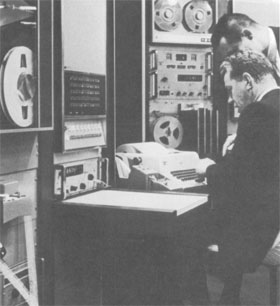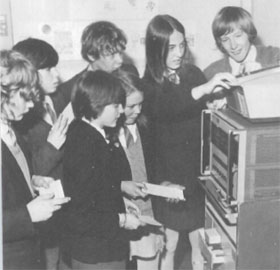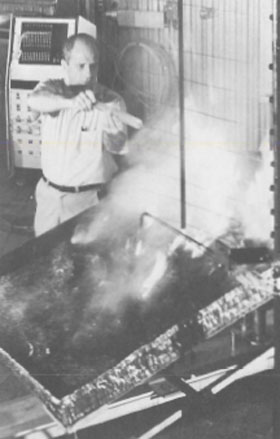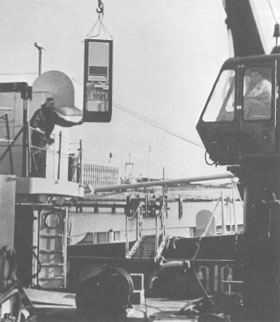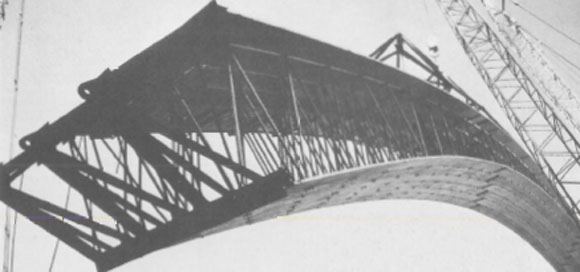

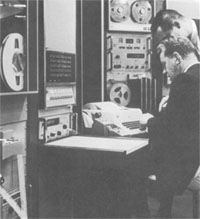 |
Passing the 10-year mark
4 pages from the October 1976 MEASURE Magazine
The contents, word for word, and photographs are reproduced below. The original newspaper page layout's incompatibility with Web page layout, and the necessity for good readability are the only reasons for this reconstruction.
HP's computer business:
Passing the 10-year mark
With the introduction of the 2116A
Ten years ago, MEASURE reported on the introduction of HP's first computer, the 2116A. At that time, we said that if automobile technology could possibly have advanced at the same rate as computers in the previous decade, we could have bought a car capable of 30,000 miles per hour for one dollar, f.o.b. Detroit. Now, ten years after HP's entry into the computer business, we can't resist applying our admittedly fanciful analogy to the decade from 1966 to 1976. It turns out that if the cost, the increased speed and power of today's computers were equaled with automobile advancements, our (then) Mach-39 car would now travel at a mind-blowing 75,000 miles per hour and would cost less than 10 cents. 1976 marks two other significant anniversaries in the computer field in addition to HP's tenth. The first sale of a computer, the Univac I, took place 25 years ago. Sold by the company now called Sperry Rand, the first Univac I filled a huge room in the headquarters of the U.S. Census Bureau. |
Five years before that, in 1946, the very first electronic digital computer was unveiled at the University of Pennsylvania. It was called ENIAC, for Electronic Numerical Integrator and Computer. ENIAC was a thirty-ton monstrosity that occupied 15,000 square feet of floor space and contained 19,000 vacuum tubes. Dozens of scurrying technicians had difficulty keeping it in operation for more than a half hour. Its memory was limited to twenty ten-digit numbers. And although its computing power and speed seemed impressive at the time, the new HP-67 hand-held programmable calculator is far more powerful. The computer has certainly come a long way in thirty years. But just how far has HP's own computer business come in the last ten? |
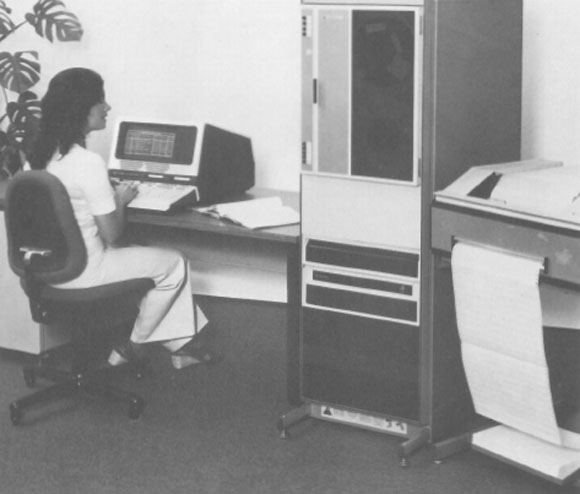 |
|
| The most recent addition to HP's computer lineup is the HP 1000 family of small computer systems. Designed for computation, instrumentation and operations management applications, it offers a new processor that executes programs 60 to 100 percent faster than previous models. To begin with, it was conceived by the former Dymec Division as an extension of HP's line of measuring instruments. Today HP offers computers that are adaptable to all kinds of specialized applications, as well as general-purpose computers that can do dozens of jobs at once and compete with the likes of IBM. Derek Smorthit, an HP sales manager in the United Kingdom, put it in perspective rather graphically. "The reason for introducing a computer at that time was to complement our instruments activity," he said. "Since then, the tail has succeeded in not just wagging the dog but whirling it around!" Learning from customers ...Feeling its way in an unfamiliar business, HP was learning much from its customers."They started showing us all kinds of things our computers could do besides data acquisition," says Bruce Noel, who has been in HP computer marketing for the past seven years. "They showed us that the same computer that collected the data could also analyze it." |
"HP's time-sharing minicomputers were particularly well qualified for the educational market because they offered economical solutions to schools. We offered the lowest cost per terminal, so educators could use the system to teach computer technology or as sort of a 'super calculator' in the classroom. And they could write programs for computerassisted instruction, or CAl, using HPdeveloped application programs." |
The central batching and processing facility in Palo Alto is still sometimes called the "2116 room" after the computer that was originally used in the system. All things to all people ...In the 1930's, the British mathematician and scientist A. M. Turing envisioned a universal computing machine of the future. The "Turing machine" supposedly would store an unlimited amount of information and be able to simulate anything.
Students at Ainslie Park Comprehensive School in Edinburgh, Scotland, load a mark reader with cards they've programmed at their desks using an ordinary lead pencil. Low-cost HP equipment and software are used in schools all over the world, and HP was the first minicomputer manufacturer to publish textbooks for use with classroom computers.
At DeAnza College in Cupertino, California, an HP computer system in a psychology lab analyzes brain wave activity for experiments in animal and human behavior. At the same time, the computer directs other terminals collecting data such as heart rate, body temperature and galvanic skin response. |
In Macon, Georgia, an HP computer collects and analyzes data from miniature forest fires. The idea is to learn to control the amount of smoke produced under different forest and weather conditions so that forests can be systematically burned. Such "prescription burning" prevents devastating wildfires, controls tree diseases and helps prepare planting sites. The complex relationships studied with the aid of the computer involve forestry, physics, chemistry, meteorology, mathematics and engineering.
|
| "We're still very committed to instrumentation, too," says Marco Negrete, Group engineering manager. "We want to reach users like ourselves, which means we'll concentrate mainly on design, process control, data collection, what we call operations management, and accounting and financial."
|
The 2116A that bears serial number 1, pictured in....1967 dangling over the deck of the research vessel Cham., is still in use today. Tom Aldrich, who was then a programmer for Woods Hole Institute of Oceanography, today says it was "the most reliable piece of equipment I've ever worked with." In all the years he used it, he recalls only three times that the 2116A gave him any problems. "In fact," he said, "I have used that experience to establish a standard for minicomputer operation."
Using an HP 9600 high-speed computer system,
With the help of HP computers and peripherals, Trus Joist Corporation of Boise, Idaho, designs complex wood and steel structures like this section of a stadium dome. The company's distributed system includes an HP 2100 computer and twelve optical mark readers located in offices throughout the U.S. and Canada. |
|
|

